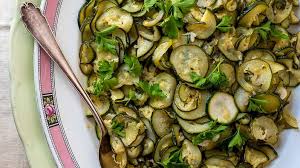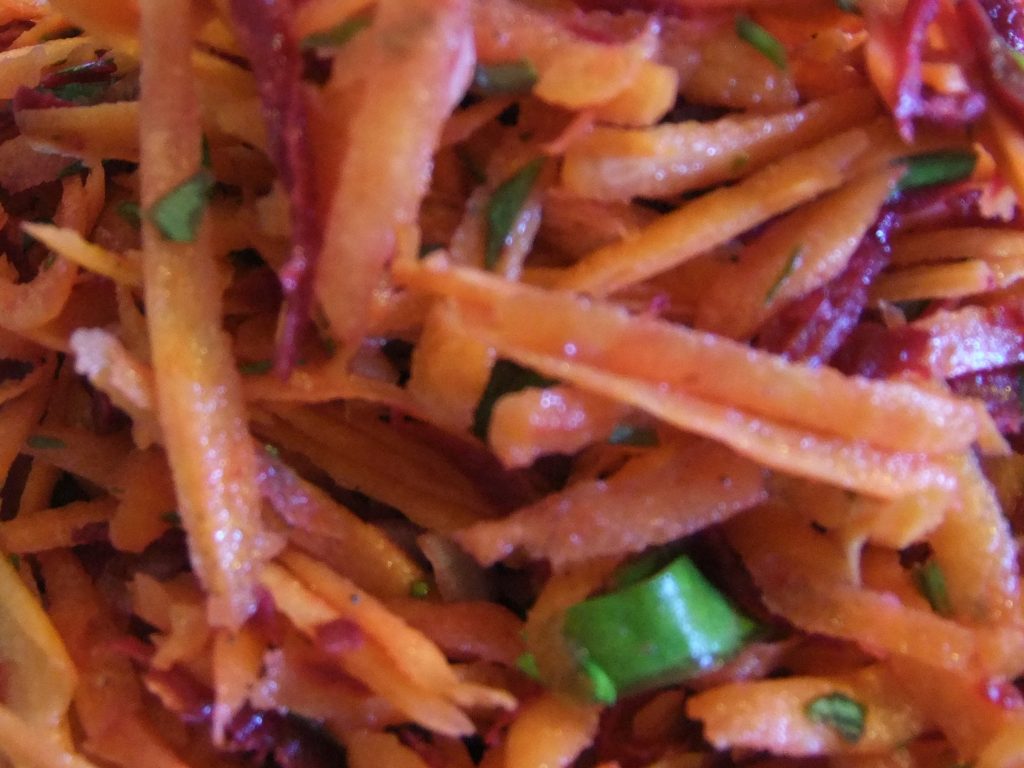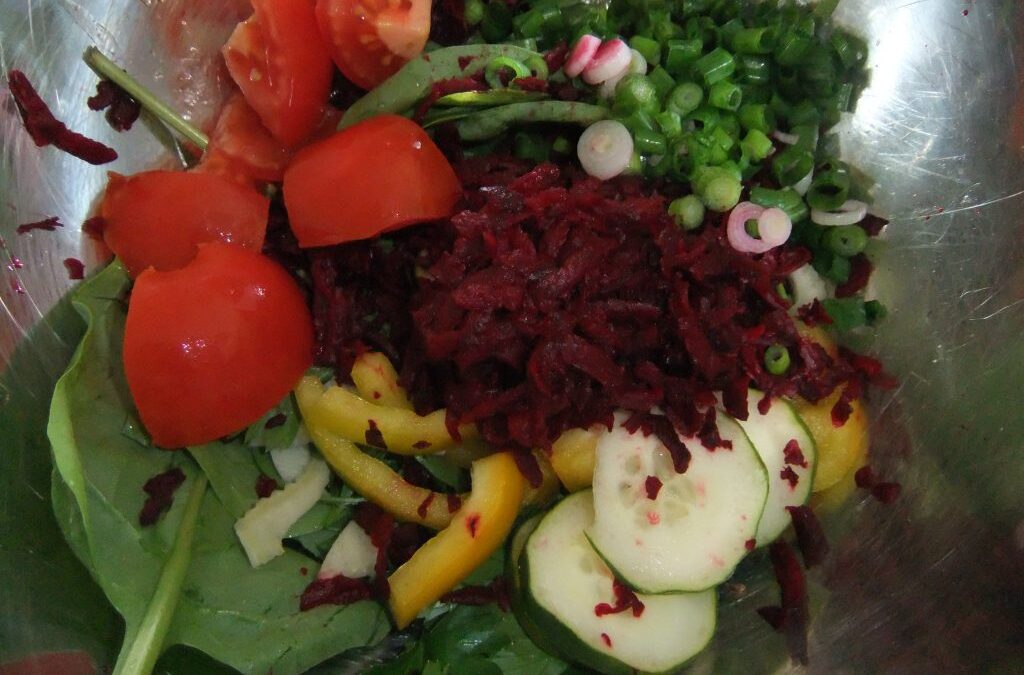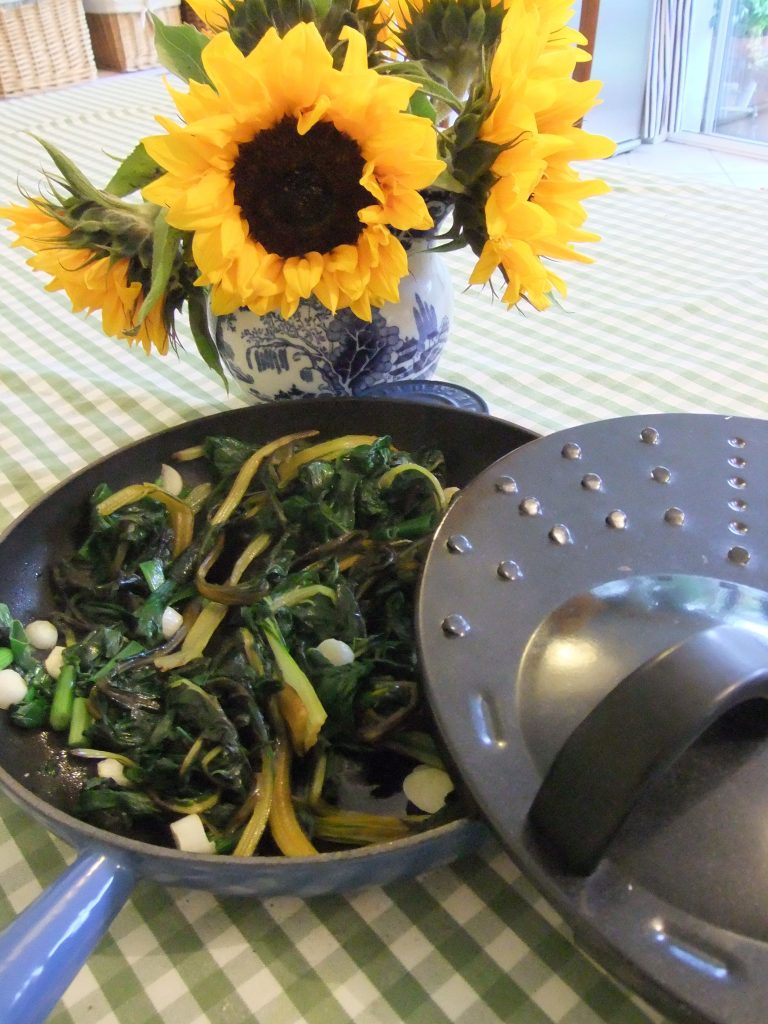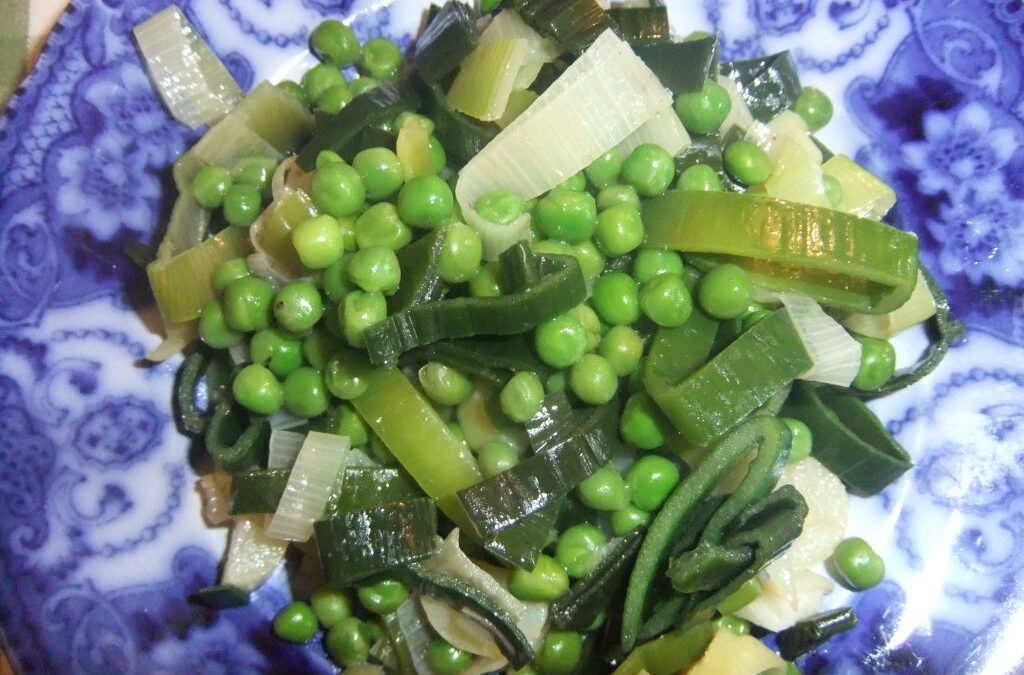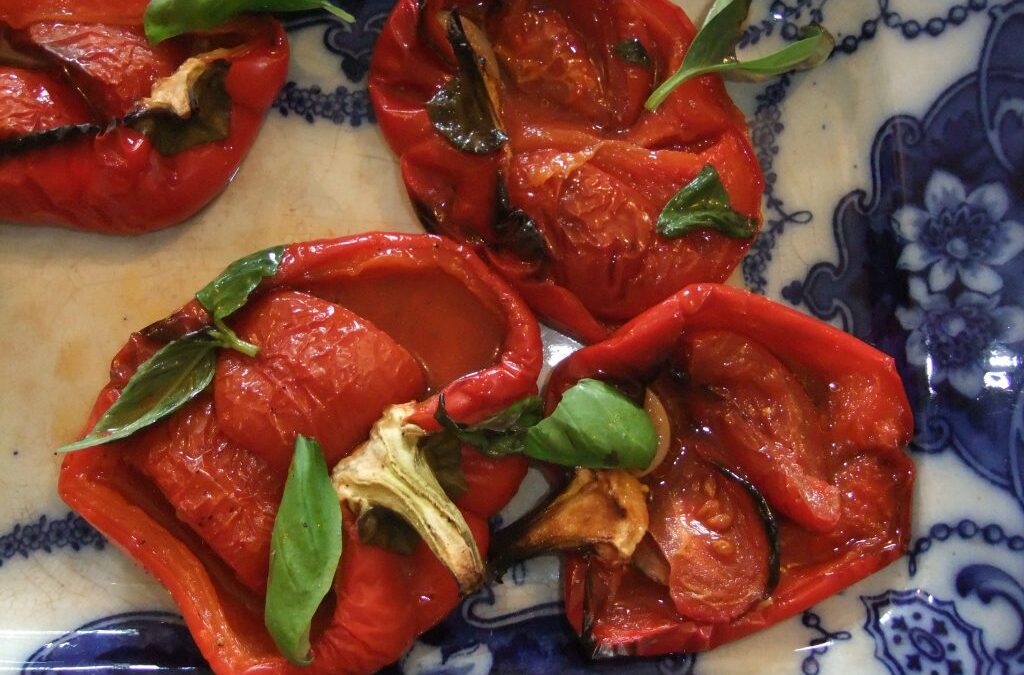
Aug 6, 2013 | Anna's Best Recipes, Sides, starters, soups & snacks
This is an Italian technique for cooking courgettes which I learned as an au-pair in Rome a few decades ago. Thanks, Signora Pilato. It’s really simple but really lovely. It goes with nearly anything.
For 2:
4 medium courgettes
Extra virgin olive oil
2 cloves garlic
Black pepper
1. Put a heavy-bottomed frying pan on medium heat to warm while you peel the garlic cloves and slice them into quarters. Throw them into the pan with about a tablespoon of olive oil to soften slightly while you prepare the courgettes.
2. Wash the courgettes, slice them into disks of say 1/2 – 3/4 cm thick. You don’t have to be too precise here – it’s a rustic dish. Throw onto the pan, turn the heat down low, stir around to coat with the garlic and oil, and cover with a lid (or large plate). The lid is important because this means the courgettes will cook in the steam, rather then (unhealthily) frying and burning. The juices from the courgettes will stop everything from burning provided the heat is low enough. Stir from time to time to check everything is cooking but not burning. If it’s getting too brown, add a tiny amount of water and turn the heat down a little.
3. After about 15-20 mins, stirring occasionally, the courgettes will be softened and start to turn a little translucent and slightly browned in places. They are now done. Take off the heat and top with a few good grinds of black pepper and maybe a little more olive oil. It will stay warm, covered, in the pan, for quite a while.
Variation:
If you are feeling fancy and don’t need to avoid dairy, you could sprinkle some freshly grated parmesan over your courgettes after piling on your plate.
Why this dish is good for you:
Courgettes are a rich source of fibre and are a low-carbohydrate vegetable you can eat in unlimited quantities without gaining weight. Braising or steam-frying is a good, low-temperature way of cooking vegetables and tastes great.

Aug 6, 2013 | Anna's Best Recipes, Sides, starters, soups & snacks
I love the jewel-like colours of this super simple salad. The zingyness of the lemon juice and mustard contrasts beautifully with the earthiness of the beetroot. We had it on a bed of dressed green leaves and avocado yesterday in the garden for lunch, with the super simple butterbean salad I just posted. Because of the antioxidant power of the lemon juice, mustard, and olive oil, this salad keeps for up to 2 days in the fridge. do make sure to add the lemon juice dressing immediately after you have grated the carrot and beetroot, otherwise, they oxidize and go brown.
4 medium carrots, peeled or scraped
1-2 small raw beetroot, peeled
2 small spring onions or 1 tbsp chopped red onion
1 level tsp mustard, ideally Dijon, but English or wholegrain would do
1 tbs lemon juice
1 tbs extra virgin olive oil
Pinch of Himalayan salt or Atlantic sea salt
Black pepper
Optional health boost: 2 tbsp chopped parsley
1. First make the dressing by mixing in a large bowl the mustard, juice, olive oil, salt, and 10 good grinds of black pepper. 2. Now slice the onion and grate the carrots and beetroot and add to the bowl. Mix well and serve with some green salad and whatever protein you are eating – lean meat, fish, eggs, beans/pulses.
Why this recipe is good for you:
Beetroot is high in chromium and betaine, nutrients that help your body process the natural sugars in the beet. In processed sugar, where sugar beets are stripped of their nutrients, all you get is the sweetness, without the chromium and betaine your liver needs to get rid of it harmlessly. Carrots and beets, like all root veg, are high in carbs so take the place of potatoes or bread in a meal. Carrots are a great source of beta carotene. This helps liver function, gives your skin a golden glow, and is a powerful antioxidant, helping protect your skin and eyes from UV or age-related damage. Mustard, lemon juice, and olive oil are also rich in antioxidants that help you maintain beautiful, clear skin. Extra virgin olive oil is also rich in vitamin E, which moisturises your skin from within. Healthy skin does not need body moisturiser. Virgin olive oil, eaten raw, also aid long-term weight loss when added to your daily diet. Piperine in black pepper helps your digestive system absorb nutrient minerals.

Aug 6, 2013 | Anna's Best Recipes, Main courses, Packed lunches, Sides, starters, soups & snacks
This is a salad we eat most days for lunch with some protein like chicken, smoked fish, a bean/pulse salad or a couple of eggs. The main thing about a salad is it needs to be almost completely raw, take up at least 50% of your plate and have lots of different colours to give you a range of nutrients. You’ll see some blanched frozen peas in the picture here, because I love them. (Thaw frozen petit pois in sieve under hot tap, put in bowl, cover generously with boiling water, leave 1 min, strain, run under cool tap and add to salads). If you’re packing this lunch to eat later, simply throw in handful frozen peas – will keep everything cool and take a couple hours to melt.
If you’re in a hurry you don’t have to have all the ingredients – mix and match.
For 1:
Leaves (choose one or 2, more if you want):
A generous 2-hand handful torn up: choose from rocket, chicory, lettuce, endive, radicchio, organic baby spinach, nasturtium leaves, watercress, pea shoots etc.
Colours (choose 3 or 4, more if you want):
1 large tomato or handful cherry tomatoes , cut in bite size pieces
2 spring onions or 1/4 red onion, sliced thinly
1/2 red/yellow pepper, sliced
Cup of sliced cucumber, courgette, fennel or celery or a bit of everything
Grilled artichokes (drain off the low-grade oil before adding)
1 tbs olives
Healthy Fats:
Optional: 1/4-1/2 soft avocado, cubed (healthy fats aid weight management)
1-3 dsp extra virgin dressing https://www.annacollins.ie/mediterranean-salad-dressing/ OR https://www.annacollins.ie/asian-dressing/
Starch (not more than 1/4 of your meal though):
beetroot (cooked and sliced or raw and grated), small carrot, peeled and grated, thinly sliced raw butternut squash, some leftover cooked baby boiled potatoes, sweet potatoes or roasted squash
Gut-bacteria modifying boost:
1 clove raw garlic, crushed
Optional carbs (no more than 1/4 of the meal):
Grated carrots
Grated or chopped beetroot
Cold cooked potatoes (NOT for SC diet)
1. Throw everything in a big bowl, add 1-3 dsp extra virgin oil-based dressing and toss til coated.
2. Eat with a palm sized portion meat, fish, couple of eggs or a cup of cooked beans/pulses.
Why this is good for you:
Fresh raw vegetables, especially when organic, are packed with vitamin C and biofoavonoids. These strengthen skin and connective tissue, speed healing and help prevent digestive disorders. You need vitamin C from raw foods, folate from dark green leafy veg (eg spinach, chard, broccoli), and bioflavonoids to help maintain digestive wellness. Greens are also rich in magnesium, which helps you relax your mind and body and fight infections.
Getting into the habit of eating a salad every lunchtime is one of the best things you can do for your health. Veggies in your daily diet also give you a beautiful golden skin tone after 6-8 weeks, according to a study I quoted in one of my e-newsletters last year. Spices and herbs in my special Mediterranean dressing lower numbers of “bad” bacteria in your gut and support growth of healthy bacteria that impact on everything – even weight management and mood.

Aug 1, 2013 | Anna's Best Recipes, Sides, starters, soups & snacks
We were once in a rustic trattoria in Puglia where there was no menu. The owner just came out of the kitchen and told you what they were going to feed you. One of the courses was local greens (cima di rape) braised with olive oil and garlic and liberally sprinkled with Parmesan. It was incredibly good. Since that holiday we often cook greens by braising them with olive oil and garlic, rather then steaming. Serve as a side to a piece of meat or fish, or maybe an omelette or a simple piece of smoked mackerel or trout.
1 x 500g bag chard or organic* spinach leaves
3 cloves garlic, roughly chopped into quarters
3 spring onions (optional) cut into 2cm lengths
Extra virgin olive oil
Freshly ground black pepper
Optional (avoid for dairy-free diet): 1 tbs freshly grated Parmesan cheese
1. Put a frying pan (ideally a heavy-bottomed one) on a medium heat, add the garlic and white parts of the spring onion and 1 tbs olive oil. Cover with a lid or plate and cook until softened and slightly translucent.
2. Meanwhile wash the chard/spinach, shake the excess moisture off the leafy greens (don’t dry them completely or they will burn). If the leaves are large, cut into approximately 5cm lengths (across the thick stalks) and add to the pan along with the green parts of the spring onions. Cover and cook gently until wilted. If you use baby spinach or chard this will only take a couple of minutes. If you use larger leaves it can take 10-15 minutes.
3. Eat hot or lukewarm – they will keep warm, off the heat, in the covered pan for quite a while.
Why this is good for you:
First of all why do I stress “organic” spinach leaves? Because spinach is in the top 3 most agri-chamical-contaminated produce. Agri-chemicals like herbicides disrupt both our gut bacteria and our hormonal systems. Our hormonal systems need to work well for energy, motivation, mood, proper thyroid function, freedom from hormone-related diseases and much more. Chard and spinach, because they are dark green leafy veg, are very high in magnesium and folic acid. If you have digestive disorders, acne, psoriasis, or eczema, or if you are stressed, you could need more of these nutrients. Folic acid and magnesium are essential for liver function and mental health. Most Irish people are deficient in magnesium because don’t eat enough magnesium foods and we eat and drink things that deplete it from your body – coffee, sugar, refined foods, for example. Stress also depletes your nutrients. Celtic people also often have altered folic acid metabolism. This genetic issue may predispose us to alcoholism and depression.

Jul 30, 2013 | Anna's Best Recipes, Breakfasts & smoothies, Main courses
This was one of my favorite breakfasts on a weekday when I didn’t have that much time and I didn’t have to be gluten-free. Now that I know I’m coeliac I use the gluten-free alternatives mentioned below. Cooking in the oven makes it handy, because (unlike grilling) you don’t have to watch it every minute. These Taifun brand sausages are vegan and contain 11% protein so are great for keeping you satisfied for longer. Check out my “larder” on the menu for where to buy these and other unusual foods. Make sure you get the “grill herb sausages” though, they are the nicest. These sausages are not gluten-free as they contain soya sauce and small amounts of oats (which can be contaminated with gluten grains). For the gluten-free option, see the Taifun Basil Tofu option below in the recipe. You could also eat this for a light lunch or dinner. All the Taifun products keep for ages in the fridge.
For 1 person:
1 tomato
1 medium courgette
2 Taifun grill herb sausages (these contain gluten, for gluten-free- slice 1/2 a block of Taifun Basil Tofu or Tofu Rosso into 3 thick slices instead)
Extra virgin olive oil
1 tsp dried oregano or 1 tbsp chopped fresh oregano
Freshly ground black pepper
- Put the sausages on a baking sheet in the oven and switch on to 170C (or 150C in a fan oven). Wash the courgette and tomato. Halve the tomato and slice the courgette lengthways – sliced 1/2-2/3 cm thick is just about right, I think.
- Leave the sausages to cook in the heating-up oven for around 25-30 minutes while you shower or generally get ready for the day.
- After 25 mins remove the baking sheet from the oven. The sausages or basil tofu should be swollen up and slightly coloured now. Add the courgette slices and tomato halves and pop into the oven for another 5 minutes. This way the veggies will be hot but not mushy. They will retain lots of nutrients this way.
- Arrange everything on a plate, drizzle a teaspoon of olive oil over the courgette slices, sprinkle the oregano over the tomatoes, and add a few good grinds of black pepper. Why this recipe is good for you:
The oregano and tomatoes in this recipe are packed with antioxidants that help your health – by lowering inflammation, delaying ageing, and (in the case of oregano) inhibiting the growth of pathogenic (“bad”) organisms in the gut. Research suggests that unfermented soya products (eg soya milk, textured soya vegetable protein) are not likely to be helpful to health whereas traditional products that are fermented (fermented tofu, tempeh, miso, natto) have lots of evidence to support usefulness in adult hormonal health, especially in relation to breasts and prostate. Fermented soya products are an excellent source of high-quality protein to keep you feeling fuller for longer. If you have autoimmune conditions though, you may need to avoid soya products.

Jul 28, 2013 | Anna's Best Recipes, Sides, starters, soups & snacks
I dreamed up this easy way with chicory this evening, to go with slow roast free-range pork. We also had my braised sliced courgettes alongside, which I will post shortly. The lovely bitterness of chicory cuts the fattiness of the pork, helping you digest it. You could also serve this as a starter, with a sprinkling of parmesan, or a tablespoon of chopped, raw walnuts.
For 2:
2 medium heads of chicory, treviso, or radicchio, rinsed, then halved lengthways
Extra virgin olive oil
Freshly ground black pepper
A pinch of Atlantic sea salt or Himalayan salt
Optional: 2 DSP freshly grated parmesan cheese (avoid for dairy-free)
- Preheat oven to 200C (fan 185).
- Place the chicory in a roasting tin, cut side up, and drizzle over about a dessert spoon of extra virgin olive oil.
- Roast for 15-20 minutes in the oven until wilted.
- Serve with a few good grinds of black pepper, a pinch of salt, and another drizzle of extra virgin olive oil. If you are feeling decadent, sprinkle a teaspoon of freshly grated parmesan over each half.
Why this is good for you:
Chicory, radicchio, and treviso are examples of foods that help you to digest a fatty meal. This is because their bitterness stimulates the flow of bile and digestive enzymes from your gallbladder. This helps break down (emulsify) fat into tiny droplets, which can then be digested all the easier by the digestive enzymes made in your pancreas and also in your small intestine. Other foods/drinks that do the same thing include dandelion coffee, dandelion leaves, rocket, and bitter apple sauce made from cooking apples.

Jun 24, 2013 | Anna's Best Recipes, Sides, starters, soups & snacks
This is inspired by a classic French side dish of lettuce, shallots, and peas. It’s healthier because you don’t overcook all the vegetables, nor do you need to smother it in a lot of butter to make it taste good. This is a great side dish to serve with roasted meats or grilled fish.
3 medium-large leeks, white and green parts, cleaned and sliced into 1/2 cm disks
About 250g or 2 mugs frozen petit pois (baby peas)
2 tbsp water or water leftover from steaming vegetables
1 large clove garlic, peeled and thinly sliced
1 tbsp extra virgin olive oil
Freshly ground black pepper
1. Into a large, heavy-bottomed saucepan or frying pan with a lid, place the leeks, the garlic, the olive oil, and the water.
2. Cover with a lid and cook on medium heat until the leeks are slightly wilted. While this is happening, rinse off your peas with hot water to get the icicles off and allow them to thaw. I usually do this by putting them in a sieve and pouring a kettleful of boiling water over them.
3. When the leeks are softened but still bright green add the peas, stir well, cover, and simmer for about 2 minutes until the peas are hot.

Jun 21, 2013 | Anna's Best Recipes, Sides, starters, soups & snacks
Everyone loves these. Eat as a starter with wholemeal gluten-free bread or (if you eat a little gluten) fresh 100% rye sourdough bread to soak up the sweet juices. Last week we served them as a side with marinaded roast chicken pieces on a bed of cooked millet (with basil pesto and sliced spring onions stirred in). Yum!
I’m not usually an anchovy lover but here they really do make it much more delicious!
For 4:
4 red peppers
4 medium tomatoes
8 small anchovy fillets
2 cloves garlic
8 dsp (dessertspoons) extra virgin olive oil
Black pepper
Fresh basil leaves
- Preheat oven to 180C
- Cut peppers in half lengthways, remove seeds, keep green stalks intact, and lay in a lightly oiled roasting tin or ovenproof dish.
- Peel garlic, slice thinly and divide between the pepper halves.
- To each pepper, half add an anchovy that you snipped into rough pieces.
- Quarter tomatoes, remove the woody centre, and place 2 pieces in each pepper hal
- Spoon 1 dsp oil into each pepper half and season with freshly milled black pepper.
- Place on a high shelf in the oven for 50 mins to 1 hour – they should be wrinkled and semi-collapsed and filled with lots of lovely sweet garlicky pepper juices.
- Garnish with a few scattered basil leaves.
